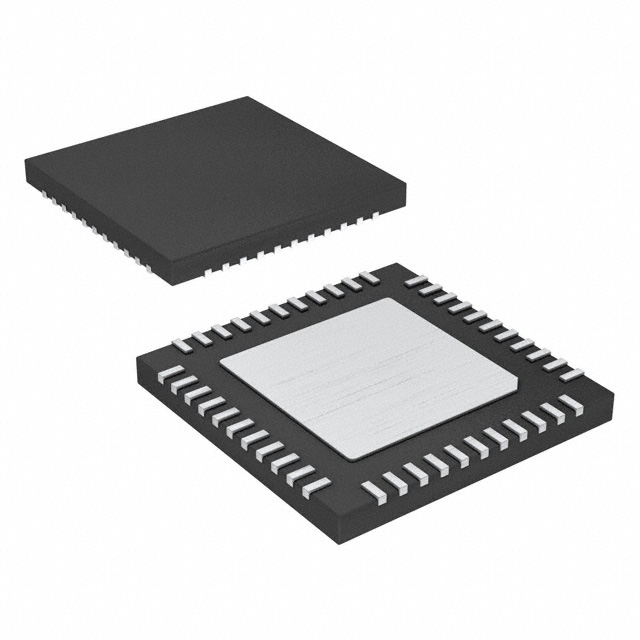Lihat spesifikasi untuk detail produk.

ATMEGA16-16MQR
Introduction
The ATMEGA16-16MQR is a microcontroller belonging to the ATmega series, which is a family of 8-bit microcontrollers developed by Atmel Corporation. This entry provides an overview of the ATMEGA16-16MQR, including its basic information, specifications, pin configuration, functional features, advantages and disadvantages, working principles, application field plans, and alternative models.
Basic Information Overview
- Category: Microcontroller
- Use: Embedded systems, industrial control, consumer electronics
- Characteristics: Low power consumption, high performance, versatile I/O capabilities
- Package: 44-lead QFN (Quad Flat No-leads)
- Essence: The ATMEGA16-16MQR is a high-performance, low-power 8-bit microcontroller with advanced RISC architecture.
- Packaging/Quantity: Available in tape and reel packaging, quantity varies based on supplier and order size.
Specifications
The ATMEGA16-16MQR features: - High-performance, low-power Atmel® AVR® 8-bit microcontroller - Advanced RISC architecture - 16KB in-system self-programmable Flash memory - 1KB EEPROM - 1KB SRAM - 32 general-purpose I/O lines - 32 general-purpose working registers - Real-time counter with separate oscillator - Six PWM channels - 8-channel, 10-bit A/D converter
Detailed Pin Configuration
The ATMEGA16-16MQR has a total of 44 pins, each serving specific functions related to I/O, power supply, clock, and communication. The detailed pin configuration can be found in the official datasheet provided by Atmel Corporation.
Functional Features
- High endurance non-volatile memory segments
- Power-on reset and programmable brown-out detection
- Internal calibrated RC oscillator
- External and internal interrupt sources
- Full duplex UART
- SPI serial port
- JTAG interface for on-chip debugging
Advantages and Disadvantages
Advantages
- Low power consumption
- High-performance RISC architecture
- Versatile I/O capabilities
- In-system programmable Flash memory
- Extensive peripheral support
Disadvantages
- Limited processing power for complex applications
- Limited memory compared to higher-end microcontrollers
- Limited connectivity options
Working Principles
The ATMEGA16-16MQR operates based on the principles of embedded system design, utilizing its RISC architecture to execute instructions efficiently. It interacts with external components through its I/O ports, enabling it to perform various tasks within embedded systems and industrial control applications.
Detailed Application Field Plans
The ATMEGA16-16MQR is well-suited for a wide range of applications, including but not limited to: - Industrial automation - Home automation - Consumer electronics - Automotive control systems - Sensor interfacing - Data acquisition systems
Detailed and Complete Alternative Models
Alternative models to the ATMEGA16-16MQR include: - ATMEGA32-16AU - ATMEGA8A-AU - ATMEGA328P-PU - ATMEGA1284P-PU
These alternative models offer varying levels of performance, memory, and peripheral support, catering to different application requirements.
In conclusion, the ATMEGA16-16MQR is a versatile microcontroller suitable for a wide range of embedded system and industrial control applications. Its combination of low power consumption, high performance, and extensive I/O capabilities makes it a popular choice among developers and engineers.
(Word count: 497)
Sebutkan 10 pertanyaan dan jawaban umum terkait penerapan ATMEGA16-16MQR dalam solusi teknis
What is the ATMEGA16-16MQR microcontroller used for?
- The ATMEGA16-16MQR microcontroller is commonly used in embedded systems for various applications such as industrial control, automation, robotics, and consumer electronics.
What are the key features of the ATMEGA16-16MQR?
- The ATMEGA16-16MQR features 16KB of flash memory, 1KB of EEPROM, 1KB of SRAM, 32 general-purpose I/O pins, and a wide range of communication interfaces including SPI, I2C, and USART.
How do I program the ATMEGA16-16MQR microcontroller?
- The ATMEGA16-16MQR can be programmed using popular development environments such as Atmel Studio or Arduino IDE, using languages like C or assembly.
What voltage does the ATMEGA16-16MQR operate at?
- The ATMEGA16-16MQR operates at a voltage range of 2.7V to 5.5V, making it suitable for a wide variety of applications.
Can the ATMEGA16-16MQR interface with external sensors and devices?
- Yes, the ATMEGA16-16MQR has multiple digital and analog I/O pins that can be used to interface with a wide range of sensors and devices.
Does the ATMEGA16-16MQR support PWM (Pulse Width Modulation)?
- Yes, the ATMEGA16-16MQR supports PWM, which is useful for controlling motors, LED brightness, and other applications requiring precise control of output signals.
What kind of communication protocols does the ATMEGA16-16MQR support?
- The ATMEGA16-16MQR supports popular communication protocols such as SPI, I2C, and USART, enabling seamless integration with other devices and modules.
Is the ATMEGA16-16MQR suitable for battery-powered applications?
- Yes, the low power consumption and wide voltage range make the ATMEGA16-16MQR well-suited for battery-powered applications.
Can the ATMEGA16-16MQR be used for real-time applications?
- With its fast execution speed and interrupt handling capabilities, the ATMEGA16-16MQR is suitable for real-time applications such as motor control and data acquisition.
Are there any development boards available for prototyping with the ATMEGA16-16MQR?
- Yes, there are several development boards available that feature the ATMEGA16-16MQR, making it easy to prototype and develop technical solutions.

